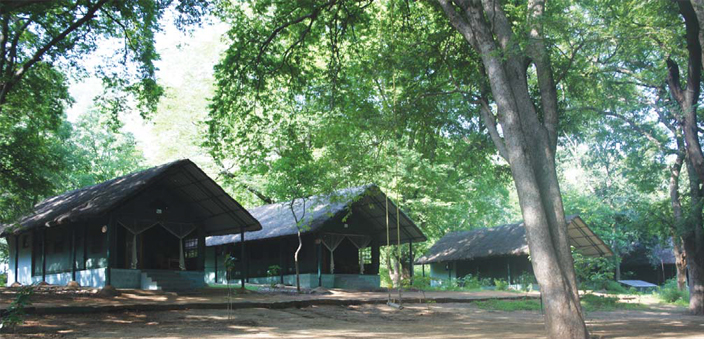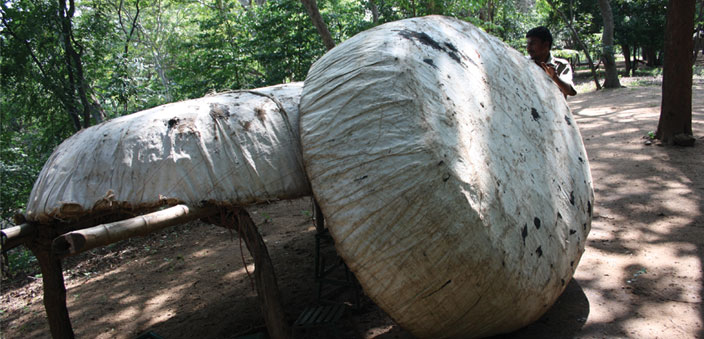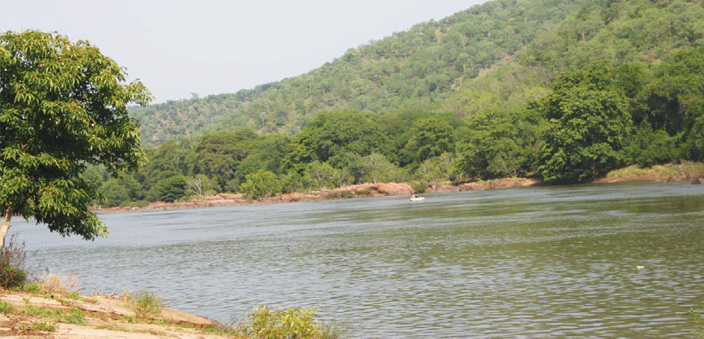THE weather in Bangalore was warm, though not unpleasantly so. But it was tempting to get out of the city for a couple of days. The landlocked city, with its congested traffic felt a bit stifling. We had for long heard about the Galibore Nature Camp on the banks of the river Cauvery, about 100 km from Bangalore. The thought of being near a flowing, gurgling river was suddenly a very attractive picture in our minds. It very soon became a compelling need!
The journey
We got out of the city and very soon got on to the Mysore Expressway. It puzzles me why the exit from a city can be so messy. It’s the same in Mumbai too. One has to negotiate bad roads, messy traffic and chaos before reaching the smooth Expressway. Once we were on the Expressway, we made good progress. The Gulmohar trees were in full bloom and formed a pleasing canopy over many sections of the road.

We arrived at Jungle Lodges & Resorts (JLR) in time for lunch. But lunch was for once farthest from our minds as we took in the resort. To begin with, JLR is not a luxury resort, as it is government owned. There are several individual cottages, each with a small sitout facing the river. The cottages are very simply furnished. What the resort lacks in luxury trappings, it makes up for, by its location. The entire resort is set in an enchantingly dark glade of thick trees through which the sunlight barely penetrates. It’s a balm for the tired mind.
The Cauvery
At first sight, the river looked gentle and placid. Too gentle I thought for the mighty Cauvery. We stood on the banks of the river, where a sign warned us to beware of crocodiles. This was almost an invitation to gaze more intently at the river and the opposite bank hoping to catch even a fleeting glimpse. We were not lucky. There were remnants of last night’s barbeque. A meditative mood descended upon all of us. We sat on the plastic chairs and contemplated the river as it flowed past.
The place takes its name from the hillock called Galibore right behind the resort. The resort is set in thick deciduous forests and is home to a variety of flora and fauna, some of which we spotted now. This river was once a favourite spot of anglers who doggedly hunted the Mahseer. But because of the poachers, who used dynamite to hunt the Mahseer, thus leading to their large-scale slaughter, a ban was imposed on fishing, which stands even today. But then fishing was not the only activity here, as we were to learn during the course of our stay.
The resort staff interrupted our reverie to inform us that lunch was ready in the ‘Gol Ghar’, literally a round thatched building which was the resort dining facility. The lunch was served buffet style and was sumptuous. The thorny, fried river fish was the highlight for us, while we also gorged on the rest of the vegetarian fare. The dining room was covered by net from all sides, and we soon understood why. Monkeys! There were many, running around the resort, but kept out of the dining area by the net and an inherent fear of people. It was a different story after we moved away, though. In a flash, they were overturning the bins, and running across tables. Soon, they were clambering up the swings and the roofs of the cottages. The staff let them be.

It was hot and humid. Bangalore had been pleasanter. The trees and dense foliage were a help. There were enough hammocks strung around the resort. There were swings tied to tall trees, which delighted my son no end. He ran amok, even as some of us settled into the hammocks with a book. Bliss! Despite the heat, the slight breeze and the swaying branches soon lulled us into a gentle sleep.
After tea, it was time to explore the Cauvery. When we reached the banks of the river, we saw coracles being loaded. A coracle is a large, round boat made of strong bamboo and painted on the outside with tar and covered by white tarpaulin, making it completely water-proof. It can seat up to four adults. We gingerly got in and the boatman pushed away. Our boatman Sreeram was very knowledgeable. He steered the boat close to the banks, where the overhang of the trees like jhumlum shaded us from the hot sun. “When the jhumlum fruits ripen, the bears come down to feast on it”, he said, pointing to the opposite bank, from where the hill rose. Suddenly, he caught a moment in the water and silently drew our attention to it.
We tracked the twin movements moving steadily through the water ahead. A crocodile! But it quietly slid away, till it was completely submerged in water. Much to the disappointment of my son!

After some steady rowing, our boatman took us close to the bank, where a huge cloud of the most colourful butterflies hovered over a bush. We briefly went on shore to photograph them. They darted around us, giving us a halo of almost psychedelic colours. Sreeram pointed to birds like the kingfisher and the green pigeon which flashed by. We relaxed in the coracle till suddenly Sreeram asked us if we wanted to experience a ‘whirlpool’. Immediately, we perked up. He took us to the deepest part of the river, gave a strong push with the oar and suddenly we were whirling around in the same spot at increasing speeds! It had to qualify as some sort of adventure sport; the adrenalin rush was so high! Slowly, the coracle ride came to a close. We disembarked and boarded the jeeps to take us back to our resort. We wondered how the coracles would make it back. Perhaps be rowed back? But no! The coracles were loaded on to the trailer behind us and we were one happy bunch who headed back.
That night it rained. The rain was a welcome relief from the sweltering heat, but there went our hopes of a barbeque on the river bank. Instead, we sheltered in the Gol Ghar, watching wildlife movies and tucking into steaming starters and wholesome food.
No one was in a mood to retire for the night. The monkeys had gone silent, there was a hush in the air, except for the gentle sound of the river. We stood and watched the river for some time. We had to be up early morning as the youngsters had been promised a bath in the river, a little upstream, where “crocodiles don’t come”. On that note we slept a dreamless sleep.
Swimming in the Cauvery
The next day dawned clear and cool. The resort staff led the way through the forest, armed with towels and a small picnic hamper. We had to walk about a kilometer upstream to reach the bathing spot. The overnight rains had created small puddles on the forest floor. The forest around the resort has many animals like the spotted deer, the endangered grizzled giant squirrel, snakes and over 230 species of birds, the guide informed us. Wild elephants visit often too, and were in fact in the habit of visiting the river spot we were headed to. We were alert, though the guides were nonchalant. They know the signs of an imminent arrival and can interpret bird sounds and animal calls.

The bathing spot was a narrow, shallow cove, sheltered from the rest of the fast-flowing river by a line of rocks and stones. The kids jumped in and splashed around, churning up the mud from the river bed. The rest of us sat on the rocks around, while the guides told us stories of floating carcasses of the mighty Mahseer laid waste by the illegal poachers, and foreigners who tragically perished because they underestimated the rapids in the river.
The swim done, we chewed on our cucumber and egg sandwiches and returned to a large breakfast at the GolGhar. We were leaving for Bangalore soon. After packing our bags, we bid goodbye to the river and the green glade which had been our home for a brief day. We promised ourselves that we would be back soon to explore yet another part of the mighty Cauvery.
Best time to visit: The best time to visit Galibore is between August and February, when the forest is rich and green, the river flows fast, and the weather is pleasant and cool.
Activities: Apart from coracle rides on the river, one can go rafting, trekking, bird watching and biking.


 [/column]
[/column]